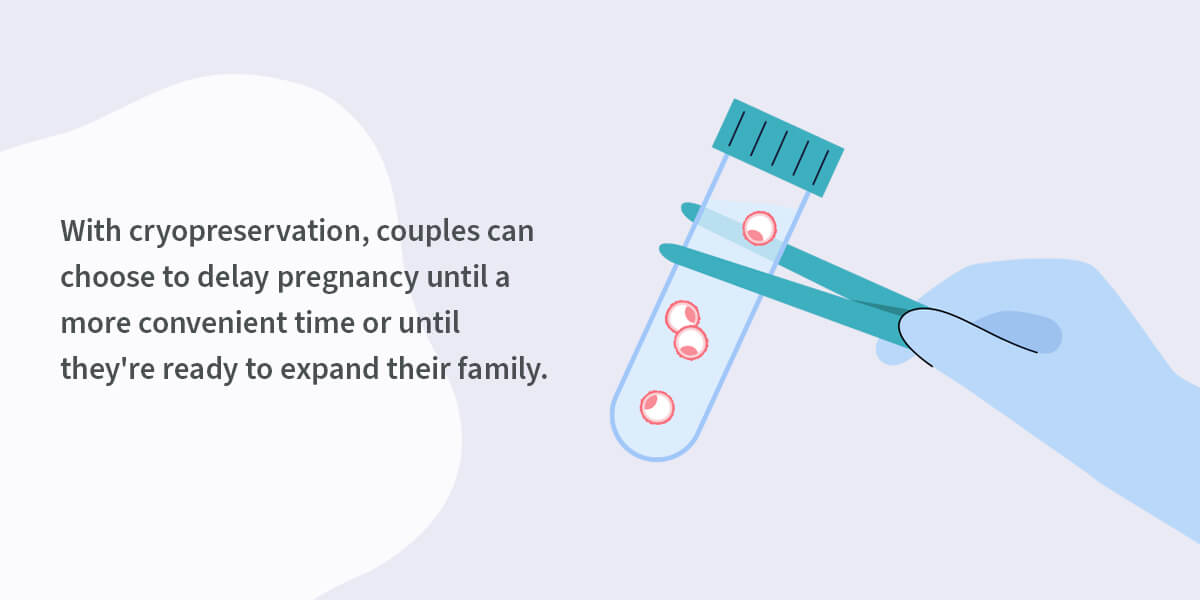In the world of assisted reproduction, cryopreservation is the process of freezing eggs, sperm and embryos to save them for future use. Cryopreservation aims to keep these biological materials viable and functional until the individual is ready to use them in fertility endeavors.
Embryo cryopreservation is an excellent option for couples who want to preserve their fertility for the future. Learn more about cryopreservation below to determine if this innovative procedure may be right for you.
Why Cryopreservation?

Couples or individuals choose embryo freezing for various reasons. Cryopreservation often happens after people receive fertility treatments.
These treatments unite eggs and sperm, sometimes creating extra embryos. Women can freeze additional embryos to use later in the following situations:
- They want to delay or cancel uterus implantation after fertilizing an egg.
- They want to postpone fertility procedures.
- They want a backup in case initial fertility treatment attempts fail.
- They want to give embryos to other women who wish to conceive or to medical research rather than waste them.
Another common reason for embryo or egg cryotherapy is to preserve fertility in the face of medical treatments that may affect reproductive function, such as radiation or chemotherapy for cancer. Embryo freezing helps these people preserve their fertility before undergoing treatment and use the embryos to conceive a child in the future.
Embryo freezing also lets couples time their pregnancies more effectively. With cryopreservation, couples can choose to delay pregnancy until a more convenient time or until they’re ready to expand their family.
Finally, some couples may choose to freeze their embryos as a form of family planning in case they experience infertility or other reproductive issues in the future.
What’s the Difference Between Freezing Embryos and Eggs?
Egg freezing and embryo freezing are two different fertility preservation techniques.
Egg freezing, also known as oocyte cryopreservation, involves freezing unfertilized eggs. Women who wish to preserve their fertility for medical or personal reasons commonly use this method. While egg freezing can happen at any time, it’s most effective when the woman is younger and has a higher number of healthy eggs.
Embryo freezing, on the other hand, involves freezing fertilized eggs, or embryos. Couples undergoing IVF with extra embryos that aren’t immediately used for implantation commonly use embryo freezing. Women undergoing medical treatment that may affect their future ability to conceive also use embryo freezing.
Embryo freezing tends to be more successful than egg freezing because the embryos have already undergone fertilization and development and are no longer fragile eggs.
What Are Embryo Cryopreservation Advantages?
Cryopreservation’s main advantage is that it allows people experiencing pregnancy barriers to conceive later in life. The procedure can help individuals facing the following challenges get pregnant in the future:
- Becoming older
- Transitioning to the opposite gender
- Having fertility issues
- Pursuing education or career goals before starting a family
- Receiving medical treatments that may hinder fertility
- Have an upcoming stint in the military
What Are Cryopreservation Risks?
While embryo freezing is generally considered safe and effective, it comes with certain risks and limitations. One of the top risks of embryo freezing is the potential for embryo damage during freezing and thawing. Damage can lead to reduced embryo viability and developmental potential and may result in failed implantation or pregnancy loss.
Women who use embryo cryopreservation are also at a greater risk of pregnancy complications, such as preeclampsia, as well as multiple births if two or more embryos get implanted.
Finally, cryopreservation can be expensive, time-consuming and may require multiple rounds to result in a pregnancy.
What Is the Cryopreservation Procedure Like?
Following is a breakdown of the vitrification embryo cryopreservation process from start to finish.
Before Embryo Freezing
The following steps take place before the embryo is frozen:
- The woman undergoes ovarian stimulation to produce multiple eggs.
- The eggs are then retrieved and fertilized with sperm in a laboratory.
- The resulting embryos are cultured for several days until they reach the blastocyst stage, at which point they can be frozen.
- Before freezing, the embryos undergo screening for genetic abnormalities to ensure they’re safe and viable.
During Embryo Freezing
Once the embryos are prepared, the following takes place:
- The embryos are prepared carefully and placed in cryovials, which are small, sterile containers that provide long-term storage at extremely low temperatures.
- Professionals add a cryoprotective agent (CPA), a liquid that acts similarly to antifreeze, to protect embryos from ice crystals.
- The embryos are immediately placed into tanks containing liquid nitrogen at -321 degrees Fahrenheit, or -196.1 degrees Celsius.
After Embryo Freezing
When the couple or individual is ready to access the embryos, lab staff thaw and prepare them using the following steps:
- The embryos are warmed to room temperature carefully.
- The embryos are then transferred to a special culture medium to facilitate revival.
- A qualified provider then uses a thin catheter to transfer the embryos to the uterus, where they can implant and develop into a healthy pregnancy.
Frequently Asked Questions About Cryopreservation
Get answers to common questions about embryo freezing below.
How Long Can Embryos Be Frozen?
Embryos can typically be preserved safely for 10 years or longer.
Is Embryo Cryopreservation Successful?
While transferring frozen embryos is often fruitful, success can vary depending on the following factors:
- The parents’ overall health
- The mother’s age when the eggs are retrieved
- The number of eggs frozen
- The existence of fertility obstacles like uterine polyps, fibroids or endometriosis
- The status of previous fertility treatments or pregnancies
In a recent study, women younger than 38 years old who thawed 20 or more eggs had a 70% chance of a live birthrate.
How Much Does Embryo Cryopreservation Cost?
Embryo freezing costs vary between fertility centers and insurance coverage. Egg storage is typically an additional fee per year.
Hann’s Fertility Pharmacy Is Ready to Support Your Fertility Journey
Embryo freezing is an important tool in assisted reproductive technologies. It helps couples and individuals preserve their fertility for future use and offers hope and opportunity for those who have struggled with fertility. If you’re considering embryo freezing, talk to your doctor or a qualified health care provider to learn more about your options.
Hann’s Fertility Pharmacy is committed to promoting women’s health, no matter your method of conception. In addition to fertility medications and supplements, we offer fertility medication counseling, prescription refills and compression garment fittings. We’re proud to serve northern Virginia and customers throughout the U.S. via text, video or phone call. Contact Hann’s Fertility Pharmacy today to learn more about how we can help support your health.


